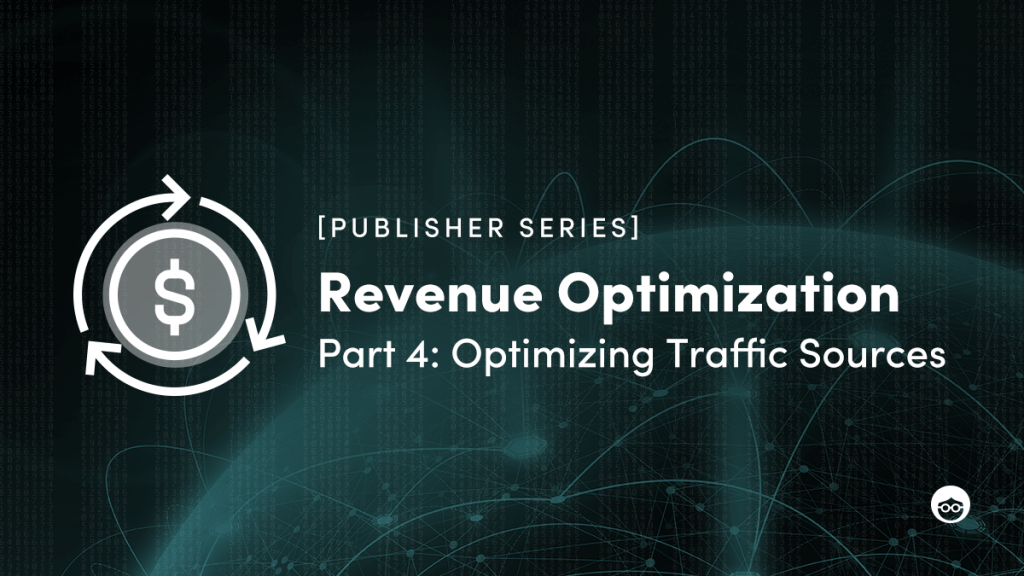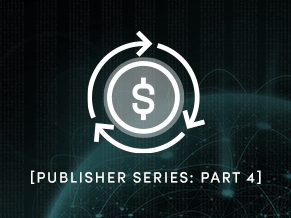[Publisher Series] Revenue Optimization, Part IV: Optimizing Traffic Sources

Traffic Acquisition — what was once a pure SEO play, has now become an increasingly powerful focus for publishers. Especially during times of crisis, as publishers try (and need) to drive higher revenue to maintain the livelihood of sustainable journalism.
And we actually have Facebook’s success to thank for this continued growth — as the platform inspired news aggregators and enhanced performing tracking. In fact, Social Media platforms ultimately became the drug that fueled a short era of practically free traffic euphoria. This played particularly well for ad-centric models that didn’t rely on reader loyalty for revenue. Instead of the long-term engagement publishers longed for, they ended up benefitting from the “one-and-done” site visits that monetized well with each impression.
Unfortunately, those days didn’t last long as platforms began mixing things up. Facebook’s algorithm changed to favor user posts versus publishers’. Google stopped pushing its News Feed. Apple News jumped in at a substantial cost to publishers. By the time publishers realized, their “side door” traffic had deteriorated and, without a solid loyal reader base, their revenues were hit extremely hard.
Since then, publishers smartened up. Not only did they start to diversify their traffic sources, but they also enhanced tracking capabilities to better understand how each performed. Beyond that, they enhanced the reader journey to increase return visits and build consumer loyalty. The result, leading up to 2020, was a more balanced, albeit still heavily ad-dependent business model. But, is this really how it shaped up? And, if so, how has 2020 tested the new “balanced” approach?
Thus, our Revenue Optimization Series continues!
And we brought in three heavy-hitters to help us answer these questions, as well as learn how various traffic acquisition strategies are currently performing:
- Brandon Beard, Director of Passive Revenue at the E.W. Scripps Company
- Fran Wills, CEO of the Local Media Consortium
- Matt Peterson, Head of Publisher Traffic Acquisition at Outbrain
If you’re just now joining us, be sure to check out our previous articles for further insights.
- Live — Part 1: Reporting, Data, and Insights
- Live — Part 2: Optimizing Existing Revenue Sources + RPMs
- Live — Part 3: Optimizing Existing Page Layouts
Insights Into 4 Major Traffic Sources
1. Organic: The Power of a Direct, Loyal Reader + SEO
As we well know by now, COVID-19 has greatly (and negatively) affected the digital media industry, especially when it comes to RPMs. But, the industry also, dare I say, benefited from the pandemic, as it inspired loyal readers to flock to local news sites in search of trustworthy news and information. “Consumers flocked to credible local news sources to find out about testing centers, school closings, and what businesses are open,” said Fran Wills, CEO of the Local Media Consortium. And this surge to reliable news sources largely offset the drops in RPMs thereby keeping many publishers’ revenue relatively flat.
Unfortunately, this was not the case for publishers across the board. As seen in the chart below from SimilarWeb (via the New York Times), less trustworthy news sources saw a flat or decline in traffic. The same was true of sites in heavily impacted verticals like Sports or Travel — although both categories have opened up slightly leading to a rebound in reader engagement.
Overall, reader loyalty remains one of the most valuable assets a publisher can have. Loyal readers consume more content, return to sites more often, and share stories with their networks, leading to greater indirect traffic. They also generate more revenue for the publisher through the consumption of digital subscriptions, e-commerce, and other value-added products. Hence, a solid strategy should start with figuring out how to gain and retain loyal readers.
SEO: Best Investment of “Free” Traffic
Time-tested and still true, SEO remains one of the best uses of development resources to drive publisher traffic. Although SEO is an ongoing investment, it’s well worth the allocated budget.
And whilst we are big proponents of proper SEO practices, in fact, Outbrain is considered net-neutral by search engines. We are not experts at it. As such, we’re not going to go into SEO tips in this segment. Safe to say that SEO is a must for all publishers — not only when they setup or redesign a site, but throughout the year, particularly as we’re seeing many browser and search engine updates.
2. Newsletters: Email Is Not Dead, Rather Evolving
As Folio reported this summer, “the key to turning one-off news consumers into repeat visitors is gaining access to their email inbox. Popular Science’s digital-only summer issue was made available for free to subscribers and non-subscribers alike, but required that users provide an email address to access it, resulting in both an increase in newsletter signups and an additional point of contact with print-only subscribers.”
That said, during the pandemic more publishers “innovated” with Newsletters than almost any other monetizable product. Moreover, clickthrough rates increased dramatically from March to April of this year — by more than 25% — greatly contributing to page views and additional monetization opportunities.
Going forward, it’s safe to say that a good newsletter strategy is top-of-mind for most publishers. Email continues to be the one place where most people start and end their days. Targeting readers with morning and evening news updates is a logical and effective way to keep relevant and engaged.
3. Push Notifications: Not Too Pushy
Back to Folio, which mentioned the success of The Seattle Times, offering readers browser notifications, “which are always great at bringing people back,” said Product Manager at TST, Audrey Clark. As shown in the chart above from WAN-IFRA, equally popular to Newsletters was implementing Live Updating or Live Blogs around the pandemic, as well as following protests for #BLM. “People continued to come back to it,” Clark said. “We were making it a habit that The Seattle Times is where you can come for immediate information like this. You don’t have to go to Twitter.”
Publishers should be aware that not all push notifications are created equally — nor are all vendors or setups user-friendly. Many are walking a thin line between value-added engagement and toolbar-pop-up-clickbait 3.0. Whilst some publishers using SaaS providers like Braze can ensure the user experience is protected, there are many push notification vendors expanding that raise a cause for concern. Some of which are pumping users with more ads than content at an alarming rate every day trying to drive clicks. Be wary, publishers!
4. Paid Acquisition: Not Just a Tool for Brands
Last, but certainly, not least — another great way that publishers can increase traffic, subscribers, and loyal consumers is through paid traffic acquisition channels. Of course, we’re biased, but Paid Acquisition strategies through Outbrain (and other Native channels — including Social, to be fair) can be very strategic and cash flow-positive.
A few years ago, the main reason publishers allocated budgets for traffic was to increase their comScore ratings, in order to raise their sales rates. However, over the last few years, publishers have consistently increased their budgets to drive new product offerings like Subscriptions, eCommerce, and Newsletter Signups. As publishers became savvier about measuring user lifetime value or revenue per user session (RPU), they started to drive arbitrage opportunities by buying traffic at a cost that was less than the monetization potential of that acquired user.
When the global pandemic hit, however, everything changed… again. During the early days, publishers’ budgets to paid traffic campaigns were slashed or cut altogether. Per Digiday, “most brands paused or slowed their ad spending at the onset of the pandemic. In April, ad spending in [some] categories was down 93% year over year, according to MediaRadar data.”
Yet, as the industry recovers, we’re seeing budgets slowly return — at least for more strategic initiatives such as Subscriptions, eCommerce, and Branded Content.
Brandon Beard from The E.W. Scripps Company confirms that they are “seeing good traction arbitraging national content across the web” — with lower cost of acquisition than they’re able to monetize. Three KPIs that this expert keeps in mind to arbitrage are:
- RPU (or, revenue per user).
- Return Visits (to increase loyalty).
- Pooled Audience Segments (that can be scaled).
For a proper paid traffic acquisition strategy, publishers need to capture both revenue and cost as granularly as possible, and in real-time, at that. For example, as Brandon explains, it may be possible to get higher margins and ROI when buying traffic at certain times of the day versus others. And another opportunity could lie with targeting Android vs. iPhone users, as they’re typically more engaging. These are highly relative to the user base and publisher content, of course, so each publisher should look to discover their own unique variants.
One area that’s become extremely competitive, and more difficult to squeeze out positive margins, is Affiliate sales. That doesn’t mean Affiliate business is bad, but it’s probably best left to organic channels and recirculation, recommends Brandon. The best game right now, though, seems to be leveraging a publisher’s loyal user segments measured against the highest RPU to buy look-alike audiences.
Matt Peterson has seen this first hand across many different types of publishers that buy traffic through Outbrain. As the market recovers from COVID and other heavy 2020 factors, he’s seeing:
- Ad-Based Arbitrage — reviving as CPMs improve.
- Branded Content — returning, but softer than before.
- Affiliate — appearing for savvier publishers.
- Subscriptions — continuing growth.
- eCommerce — still performing well, particularly to Amazon.
With or Without Cookies We Go
Of particular attention these days is the ongoing effort by browsers to reduce or eliminate the number of third-party cookies. As a result, publishers are scrambling to establish direct relationships with their readers.
A well thought out paid campaign can ensure a good percentage of overall users are logged in or otherwise giving consent to target them by the time the third-party cookie all but disappears. And as alluded to earlier, getting smarter about users, RPU and LTV should be top-of-mind for most publishers concerned about a cookie-less future. Traffic Acquisition then becomes about readers and not simply about page views.
Winding Down
Publishers should have a well thought out, and comprehensive, reader acquisition strategy — today, more than ever. As alternative sources of revenue expand, including Subscription, eCommerce, or e-Gaming, an equally diverse traffic acquisition strategy is the best way to maximize overall revenue, margins, and long-term value.
One of the biggest challenges publishers have is in aggregating and evaluating all of this data in near real-time. Most publishers treat SEO and organic traffic channels separately and differently from paid channels. This means that some users could be targeted twice, with only one side getting credit for on-site consumption. The challenge for 2020 and 2021 seems to be around data aggregation, particularly for a logged-in user vs. a cookied user.
Overall, however, we’ve seen a positive trend for the industry as “consumers sign up for newsletters, make donations, sign up for subscriptions. So, the audience side, which had been in decline for years, is now turning around,” per Fran Wills at the LMC.
Adding to that message, Brandon Beard explains that, “now is a great time to expand brand awareness and increase our user base” — hopefully, all publishers are thinking the same way.
And be sure to keep an eye out as there’s still one more part to this optimizing series.
- Live — Part 1: Reporting, Data, and Insights
- Live — Part 2: Optimizing Existing Revenue Sources + RPMs
- Live — Part 3: Optimizing Existing Page Layouts
- Live — Part 4: Optimizing Traffic Sources
- Coming Soon — Part 5: New, LTV-Driven Revenue Planning
Until then, discover how you can manage, control, and monetize your site on the Open Web.







![[Infographic] Which Ad Headlines and Images Catch Your Readers’ Attention?](https://www.outbrain.com/blog/wp-content/uploads/2024/01/ad-headlines-and-images-best-practices.png)




